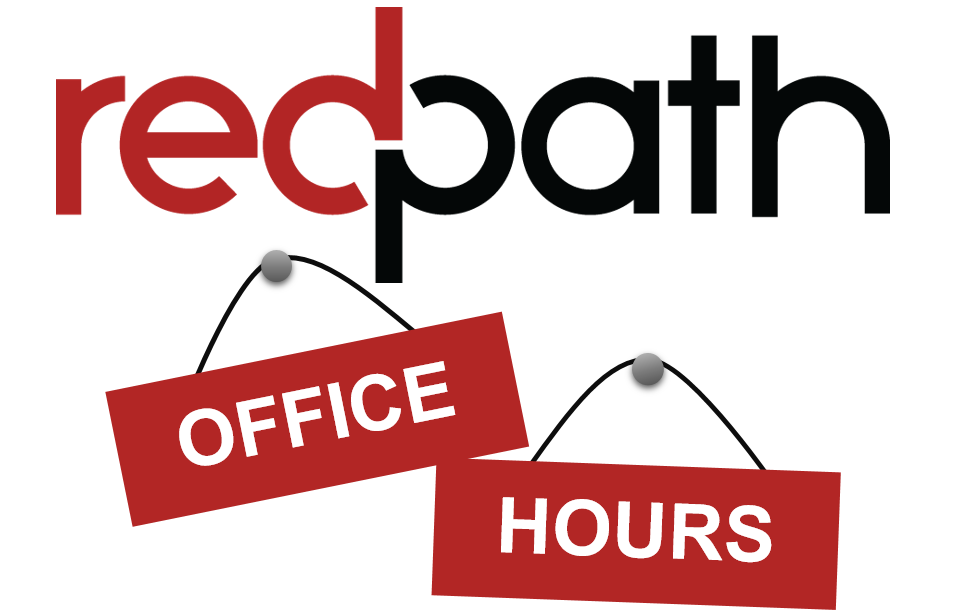Accelerating your digital transformation suddenly got much more important
 The traditional workday has completely changed, and as employees are transitioning into involuntary remote working, your on-premise infrastructure and systems have quickly become your company’s most valuable asset. But is your system ready to handle these new expectations?
The traditional workday has completely changed, and as employees are transitioning into involuntary remote working, your on-premise infrastructure and systems have quickly become your company’s most valuable asset. But is your system ready to handle these new expectations?
If you’re not sure, don’t worry. There’s still time to facilitate a successful system transition, if you start quickly.
At Redpath, we believe digital transformation is the digitization of your business-critical processes. And now’s the perfect time to quickly get alignment on what digital transformation means for your organization.
Start by asking yourself these questions:
- Do we have a digital transformation strategy? And if not, why not?
- Can I spend less on my organization’s legacy systems to impact the pace of moving my digital transformation agenda forward?
- Are the decisions I am making now putting cloud technologies on the front burner?
- Do I have legacy systems that are multiple releases and patch levels behind, with no clear upgrade path?
- Do I have a legacy system technical debt problem?
- Am I spending my budget on the right things? How can I make decisions that will help my organization save costs in the long run?
- Do I understand cloud technologies well enough to be able to make good investment choices today?
- Are business departments implementing their own IT (Shadow IT)?
- Are employees frustrated with the business value we are providing, or our ability to innovate at speed?
- Is my organization well prepared to meet the emergent functional needs of my business? Do I need to take action now to catch up?
How to Accelerate Your Digital Transformation
 While cloud-based technology can enable a digital transformation and make your application and infrastructure more current, it is not without challenges. As cloud technology has evolved over the past 10 years, many companies have rushed their efforts, thinking they can reduce their technical debt simply by moving to the cloud. Unfortunately, faster is rarely better.
While cloud-based technology can enable a digital transformation and make your application and infrastructure more current, it is not without challenges. As cloud technology has evolved over the past 10 years, many companies have rushed their efforts, thinking they can reduce their technical debt simply by moving to the cloud. Unfortunately, faster is rarely better.
While moving to virtualized cloud servers may solve some problems, selecting new cloud-based applications (e.g., CRM, ERP, contract management, call center, marketing and professional services automation applications) requires you take the time to determine exactly what you need versus trying to replicate what you have already.
Not everything can be put on the cloud to eliminate your current infrastructure and app debt. Instead, the better strategy may be to keep your current infrastructure and add a cloud cost layer on top. Whatever you decide, be thoughtful and consider your strategic plan.
Redpath uses a digital transformation success blueprinting process called the “Path to Success” to initiate digital transformation. Our process focus is to:
- Identify Executive Sponsor who can make budget, timeline and scope decisions as well as evangelize the importance of digital transformation across the organization
- Determine your Vision and Critical Success Metrics based on your organization’s value-drivers and goals
- Capture your Current State from a people, process, technology and data perspective
- Ideate your Future State, again from a people, process, technology and data perspective
- Perform a Gap Analysis to determine what you need to do to reach your desired future technology state
- Create a Roadmap and estimate so you can make changes in prioritized bite-sized phases based on business value. Total Cost of Ownership (TCO) and Return On Investment (ROI) should be metrics that drive this.
- Establish a Governance function to ensure that technology and process changes are made in a structured way, with the appropriate budget and prioritization.
- Establish a Measure and Monitor function to identify continuous improvement opportunities and inform future roadmap phases.
Above All, Stick With It!
The cloud offers the possibility to substantially reduce your legacy infrastructure and app technical debt. But there will be a lot of lifting and shifting of people, processes and data as you migrate to cloud solutions. Doing this in haste is likely to create new technical debt in the cloud and lost business value. Take your time, maintain the course and your company will be better for it in the long run.
Tackling Bite-Sized Pieces
A successful digital transformation requires moving at the speed your business demands, so starting early can be very beneficial. Firstly, decide what apps to keep or move to the cloud by focusing on quick wins with high business value. That will get your project off on the right foot.
But above all, make sure you’re applying a holistic approach to your technology migration. We often see clients where the leadership doesn’t have a clear plan of how they will reduce their technical debt and bring in cloud-based solutions. We see decisions made in departmental silos just to solve an immediate business problem. Instead, it’s better to step back and think about a holistic long-term strategy that considers the overall business need and what digital transformation means to the entire company. Carefully constructing the digital transformational agenda is key, including a balance between costs that gets the organization infrastructure current and investment that drives organizational growth. Typically, this will involve a mix of outsourcing infrastructure and investment in high business value transformations. It’s all about finding what’s right for your business need.
How to Get Started Today
The best way to begin is to start by building a digital transmission strategy and creating a success blueprint to inform that strategy.
We have seen a powerful trend to starting cloud solutions that focus on customer digital engagement. Typical cloud solutions in order of priority often include:
- Customer Relationship Management (CRM) to drive the marketing, sales, proposal and contract processes for B2B businesses, or for nonprofit program management and fundraising
- Customer Service to manage customer support cases and call center processes
- Marketing Automation (B2C, B2B and nonprofit) for omni-channel mass personalization marketing journeys
- Communities (portals) to support customer self-service / renewals / product knowledge sharing; and partner relationship management for channel partners
- B2B/B2C eCommerce for online commerce
Whichever solution you determine is right for you, now’s the time to take action on this initiative. In the current climate, organizations that can support their critical business processes for remote workers are likely to fare better than those encumbered with legacy technical debt, weak infrastructure and on-premise systems. You’ve worked hard to manage your company through the crisis so far, and aggressively shaping your digital transmission strategy now will support your business beyond current challenges and in the months and years ahead.
To learn more about honing your digital transmission strategy download our Path to Success Guide. And if your organization needs more support in the current climate, contact us to schedule a free 1:1 session with a Salesforce consultant.
With the rapid evolution of technology, Salesforce solutions are ever-changing and improving features. Contact our team for up-to-date information.


